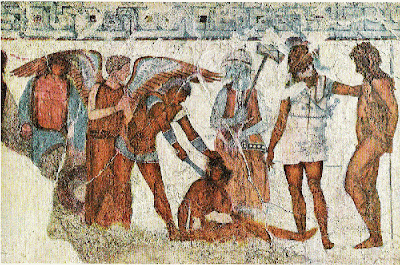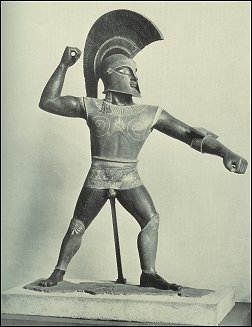Posted on 07/09/2008 9:46:57 PM PDT by SunkenCiv
|
|
|||
Gods |
To all -- please ping me to other topics which are appropriate for the GGG list. |
||
|
· Mirabilis · Texas AM Anthropology News · Yahoo Anthro & Archaeo · · History or Science & Nature Podcasts · Excerpt, or Link only? · cgk's list of ping lists · |
|||
http://www.freerepublic.com/tag/etruscans/index
Italian Builders Uncover (27) 2,000 year Old Tombs (Etruscans)
The Scotsman | 5-7-2008
Posted on 05/08/2008 1:54:01 PM PDT by blam
http://www.freerepublic.com/focus/f-news/2013225/posts
This fascinates me. Is the Etruscan language related to no other? Too bad we don’t have a Rosetta Stone for it.

The image below reminds me very much of Knossos, Crete:

Nice catch. I first saw that noted (to my recollection anyway) in an interesting book, “The Secret of Crete” by Wunderlich (it’s one of those often given a wave of the hand), but of course, the problem was that there’s a 600 year gap...
You mean to say my eyes deceive me? So, who am I going to believe, me or my lying eyes, hmmm?
There are theories ranging from the Basques to the Trojans, and the predominant opinion is that they migrated from Asia Minor sometime in the late 2nd Millenium BC. There is no widely accepted linguistic relative to Etruscan.
It is strange that no Latin/Etruscan documents have been found, since Roman culture was so widely derived from Etruscan culture, even to having had Etruscan rulers. I am sure such documents existed, the problem is that no extensive stellae existed at that period in Rome or Etruria, and any other writings in that climate would be unlikely to have survived for 2500 years. Hopefully such a document will eventually be found.
It was a Dr. V reference. :’)
Who were the Etruscans?
http://theglitteringeye.com/?p=2721
http://www.theglitteringeye.com/images/goldplaque.jpg
http://www.theglitteringeye.com/images/etruscanart.jpg
I realized that but couldn’t find what I was looking for.
http://www.varchive.org/dag/etruria.htm
ETRURIA
References
Von Vacano, The Etruscans in the Ancient World, p. 81. [After the monuments of Mycenae and Tiryns received, on the basis of Egyptian chronology, dates in the second millennium, some scholars attempted to age the Etruscan tombs by five hundred years to make them contemporary with their Mycenaean conterparts: so “striking” was the similarity, so “evident” the relation of the two architectural styles, that if the Mycenaean tombs belong in the second millennium, one expert argued, the ones found in Etruria “are probably not of inferior antiquity.” (G. Dennis, The Cities and Cemeteries of Etruria [London, 1878], vol. I, p. 265, n.2; cf. p. 368, n. 6.) But what of the contents of the tombs, which invariably consisted of Etruscan products of the eighth century and later? The surmise that this situation reflected “a reappropriation of a very ancient sepulchre” (Dennis, op. cit., p. 154) was unanimously rejected by experts (e.g., A. Mosso, The Dawn of Mediterranean Civilization [New York, 1911], p. 393). There was no reason to suppose that the tombs had been built by anyone but the people who used them; and these people first arrived on the scene in the middle of the eighth century. The relation of these eighth-century tombs to the five-hundred-years-earlier structures of Mycenean Greece has remained a puzzle. The Dawn of Mediterranean Civilization (New York, 1911) pp. 392-93; A. N. Modona, A Guide to Etruscan Antiquities (Florence, 1954), p. 92; S. von Cles-Reden, The Buried People: A Study of the Etruscan World, transl. by C. M. Woodhouse (New York, 1955), p. 180; A. Boethius and J. B. Ward-Perkins, Etruscan and Roman Architecture (Baltimore, 1970) p. 78 and pl. 47. The oldest is the Grotta Regolini Galassi, dated to ca. B.C.]
Ibid., p. 82; cf. Cles-Reden, The Buried People, p. 122. [Numerous other Etruscan cultural traits reflect Mycenaean models, something that would be not unexpected if, as the revised timetable postulates, the two cultures were contemporary, yet most difficult to account for if, as the conventional scheme requires, five hundred years of darkness intervened. (a) Columns. The types of columns used in Etruscan buildings derive from columns of Knossos and Mycenae, and have nothing in common with the Doric columns of seventh and sixth-century Greece.(S. von Cles-Redden, The Buried People: A Study of the Etruscan World, transl. by C. M. Woodhouse [New York, 1955], p. 35.) But it is presumed that no Mycenaean or Minoan structures were left standing in Etruscan times. Where, then, did the Etruscans find the models for their wooden columns? (b) Frescoes. The famous Etruscan frescoes, such as those that decorate the tombs near Veii, display an “obvious reminiscence of Crete”—however not of Crete of the Dark Ages, but rather of Minoan Crete (von Cles-Redden, op. cit., p. 143). But had not the Cretan palaces with their frescoes been destroyed many centuries earlier? (c) Burials. The sepulchral slabs used in some Etruscan tombs, especially those bearing reliefs of men and animals, resemble those found by Schliemann at Mycenae (Dennis, op. cit., p. lxix, n. 9). Also Etruscan burial customs appear to be derived from Mycenaean models (S. von Cles-Redden, op. cit., p. 150.)]
Von Vacano, The Etruscans in the Ancient World, p. 81. See I. M. Isaacson, “Applying the Revised Chronology,” Pensée IX (1974), p.p. 5ff.

Red figured Kylix from the second quarter of the fith century b.c., found at the etruscan necropolis of Vulci in the province of Viterbo in Italy. Now on view in the Museo Archeologico Di Vulci.

DNA Analysis Has Cleared Up The Origins of the Etruscans.
In 1885, an inscription in a pre-Greek language discovered in the island of Lemnos, dated to about the 6th century BC, presented many similarities with the Etruscan language both in its form and structure and its vocabulary. Herodotus’ theory, criticized by many historians, claimed that the Etruscans emigrated from the ancient region of Lydia (now western Turkey). Half the population sailed from Smyrna (now Izmir) until they reached Umbria in Italy.
Indeed, tombs discovered in ancient Lydia are extremely similar to those of the Etruscans. The Etruscans were also skilled sailors, who traded with the Greeks and Cartagena and the God of the Sea, Neptunus, was important in their religion.
The Lydian theory also links the Etruscans to the Minoans and "People of the Sea", seafaring raiders that were at war with the Egyptians in the 12th century BC. Their civilization was centered in Crete (now an island in southern Greece) and other neighboring islands (like Lemnos) and these people spoke non-Indo-European related languages. There are significantly increasing proofs that match the Crete and Minoan civilization
“A preliminary study suggests that writing on the side of the urns probably refers to a family that was called the Aneis.”
Does that family name sound familiar to anyone? Remember the oral tradition that the Trojans under Aeneas fled to Italy?
How many Archeologists and historians pooh-pooh the oral traditions of a culture, labeling them myths and legends, instead of accepting them as part of a living ethos, handed down over centuries.
Then someone with faith in the oral tradition as based on history goes out and finds Troy or the Lion Gate or in this case an actual relic with a reference to Aeneas or the Aeneid clan.
Call me a romantic, but I’m a believer that strong oral traditions, passed down over generations in a pre-history environment, accurately record events and heroes whose attributes and achievements have a basis in truth
Like all good tales, told and repeated over fires at night for entertainment and instruction of the young, these stories, enhanced by the desire of a culture for an ethos that confirms their worth, they become legendary and mythical over time with a strong overlay of religious intervention of the gods as an explanation of the unknown.
Not unlike the belief in American exceptionalism.
That’s my story and I’m sticking to it.
Do posterity a favor. When you go, make sure you’re buried with a few great books.
I need to get a scanner installed around here...
I agree. It could be a coincidence, but it could also be a common family name, or it could be the one, the only, family of that protagonist. It’s unlikely that Vergil’s tale would have been accepted had it not been woven from existing threads. :’)
Disclaimer: Opinions posted on Free Republic are those of the individual posters and do not necessarily represent the opinion of Free Republic or its management. All materials posted herein are protected by copyright law and the exemption for fair use of copyrighted works.